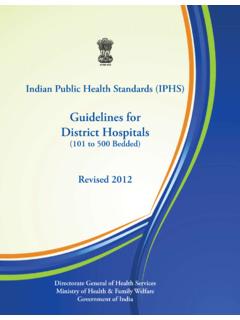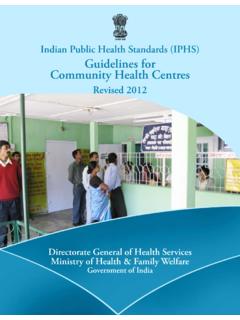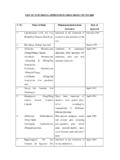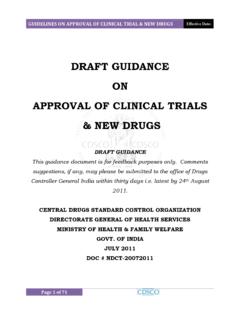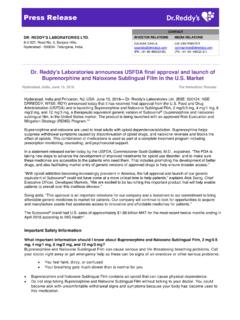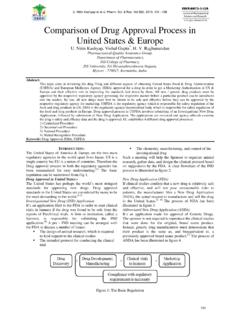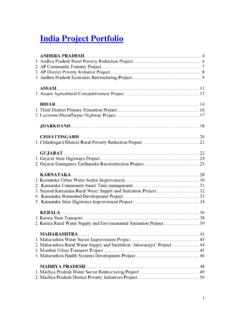Transcription of Revised National Tuberculosis Control Programme …
1 Revised National Tuberculosis Control Programme DOTS-Plus Guidelines Central TB Division, Directorate General of Health Services, Ministry of Health & Family Welfare, Nirman Bhavan, New Delhi 110011 Revised National Tuberculosis Control Programme DOTS-Plus Guidelines January 2010 Central TB Division, Directorate General of Health Services, Ministry of Health & Family Welfare, Nirman Bhavan, New Delhi 110011 Staff members at the Central Tuberculosis Division, Ministry of Health and Family Welfare, New Delhi, the Lala Ram Sarup Institute of Tuberculosis and Allied Diseases, New Delhi, the National Tuberculosis Institute, Bangalore, the Tuberculosis Research Centre, Chennai, and the World Health Organization, New Delhi, contributed to the development of the RNTCP DOTS-Plus guidelines Table of contents Page 1.
2 2. Framework for effective Control of multidrug-resistant 3. Government commitment and 4. Case finding and 5. Diagnosis and 6. Laboratory 7. Treatment of multidrug-resistant 8. Monitoring and management of adverse drug 9. MDR-TB in special 10. Treatment delivery and 11. Human resource development for DOTS-Plus under 12. Logistics of second-line anti-TB 13. Recording and reporting system ..80 Annexures I. RNTCP Request for culture and drug sensitivity testing II. History of anti-tubercular drugs III. Referral for DST Register (held at the DTC) IV. IRL Culture and DST Register V. DOTS-Plus Referral for treatment form VI. Follow-up schedule during Category IV treatment VII. Checklist for initial evaluation and treatment surveillance VIII.
3 RNTCP DOTS-Plus treatment card IX. RNTCP DOTS-Plus Treatment Register X. RNTCP CAT IV TB Identity Card XI. RNTCP Quarterly report on Category IV case finding XII. RNTCP DOTS-Plus six month interim report XIII. RNTCP DOTS-Plus 12 months culture conversion report XIV. RNTCP Quarterly report on the result of treatment of MDR-TB patients on Category IV treatment regimens registered 31-33 months earlier XV. Evaluation at completion of Category IV treatment XVI. Quarterly report on Cat IV drug logistics XVII. Roles of the various facilities under RNTCP DOTS-Plus XVIII. Job responsibilities of various categories of staff under DOTS-Plus XIX. Second Line anti-TB drugs information sheets Abbreviations and Acronyms AFB Acid Fast Bacilli CP Continuation Phase CPC Cetyl Pyridinium Chloride CNS Central Nervous System Cs Cycloserine CTD Central TB Division DMC Designated Microscopy Centre DOT Directly Observed Treatment DRS Drug Resistance Surveillance DST Drug Sensitivity Testing DTC District TB Centre DTO District TB Officer E Ethambutol EQA External Quality Assessment Eto Ethionamide GFATM Global Fund to fight AIDS.
4 TB and Malaria GLC Green Light Committee GoI Government of India GMSD Government Medical Store Depot H Isoniazid HAART Highly Active Anti-Retroviral Therapy HCW Health Care Worker HIV Human Immunodeficiency Virus HRD Human Resource Development IP Intensive Phase IRL Intermediate Reference Laboratory Km Kanamycin Lfx Levofloxacin LJ Lowenstein-Jensen LRS Lala Ram Sarup TB Institute, Delhi LT Laboratory Technician MDR-TB Multidrug-resistant Tuberculosis MIC Minimal Inhibitory Concentration MO Medical Officer MO-PHI Medical Officer Peripheral Health Institute MO-TC Medical Officer TB Control NaCl Sodium Chloride NGO Non-Governmental Organisation NRL National Reference Laboratory NTI National TB Institute.
5 Bangalore PAS p-aminosalicylic acid NTM Non-tuberculous Mycobacteria Ofx Ofloxacin PNB p-nitrobenzoic acid R Rifampicin RNTCP Revised National TB Control Programme S Streptomycin SEARO WHO South-East Asia Regional Office SNRL Supra- National Reference Laboratory SOP Standard Operating Procedures STDC State TB Training and Demonstration Centre STLS Senior TB laboratory Supervisor STO State TB Officer STR Standardized Treatment Regimen STS Senior TB Treatment Supervisor TB Tuberculosis TRC TB Research Centre, Chennai VCTC Voluntary Counselling and Testing Centre WHO World Health Organization Z Pyrazinamide ZN Ziehl-Neelsen 1 INTRODUCTION The emergence of resistance to drugs used to treat Tuberculosis (TB), and particularly multidrug-resistant TB (MDR-TB), has become a significant public health problem in a number of countries and an obstacle to effective TB Control .
6 In India, the available information from the several drug resistance surveillance studies conducted in the past suggest that the rate of MDR-TB is relatively low in India. However this translates into a large absolute number of cases and as yet the management of patients with MDR-TB is inadequate. Specific measures are being taken within the Revised National Tuberculosis Control Programme (RNTCP) to address the MDR-TB problem through appropriate management of patients and strategies to prevent the propagation and dissemination of MDR-TB. Traditionally, DOTS-Plus refers to DOTS programmes that add components for MDR-TB diagnosis, management and treatment. These guidelines promote full integration of DOTS and DOTS-Plus activities under the RNTCP, so that patients with MDR-TB are both correctly identified and properly managed under the recommendations set out in this document.
7 Finally, the guideline introduces new standards for registering, monitoring and reporting outcomes of multidrug-resistant TB cases. This uniform information management system will allow systematic, consistent data collection and analysis which will facilitate appropriate supervision and monitoring of the DOTS Plus activities and will play an important role in shaping future policies and recommendations. 2 CHAPTER 1: BACKGROUND Chapter objectives The chapter summarizes key information on the emergence of drug-resistant TB, its public health impact, experience gained in patient management, and strategies for addressing drug resistance within RNTCP. Recent developments Prevention of MDR-TB It is well known that resistance levels are higher in areas with a poorly performing DOTS programmes.
8 Use of inadequate regimens and inappropriate directly observed treatment (DOT) leads to increase in drug resistance levels in the community. It has been acknowledged that good treatment is a pre-requisite to the prevention of emergence of resistance. RNTCP recognises that implementation of a good quality DOTS Programme is the first priority for TB Control in the country. Prevention of emergence of MDR-TB in the community is more imperative rather than its treatment. DOTS-Plus services, for management of MDR-TB, are supplementary services under the expanded framework of the DOTS package. Therefore in every DOTS implementing unit of the country, DOTS would be prioritised above DOTS-Plus with the view that DOTS reduces the emergence of MDR-TB, and therefore the need for DOTS Plus over time.
9 Expansion of the DOTS package Over the past few years, the basic package of DOTS for TB Control has been expanded in many areas to include components that address additional challenges such as TB/HIV co-infection, multidrug-resistant TB, contributing to health system strengthening, engaging all care providers, empowering patients and communities, and enabling and promoting research. Emphasis on expanding laboratory capacity (smear microscopy first, then culture/drug sensitivity testing) and the use of quality assured drugs, are important parts of this more comprehensive approach to TB Control . Introduction of DOTS-Plus The first WHO endorsed DOTS-Plus programmes began in 2000. At that time, the Green Light Committee (GLC) was established to promote access to high quality second-line drugs for appropriate use in TB Control programmes.
10 DOTS-Plus pilot projects have demonstrated the feasibility and effectiveness of MDR-TB treatment in less affluent countries. In 2002, the Global Fund to fight AIDS, TB, and Malaria (GFATM) started financing TB Control programmes, including MDR-TB, thus greatly reducing the economic barrier to MDR- 3 TB Control . Since then, DOTS-Plus projects have multiplied rapidly. By the end of 2007, 67 projects in 52 countries approved by the GLC, with a cumulative total of over 30,000 MDR-TB patients, had been launched worldwide, many of them with financial support from the GFATM. Based on data and experience from these projects, practices and further scientific evidence have emerged regarding services for MDR-TB. DOTS-Plus programmes can and should strengthen the basic DOTS strategy.
